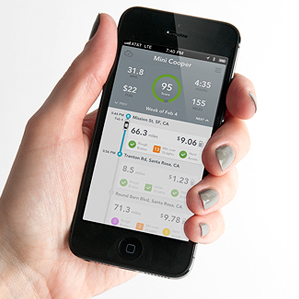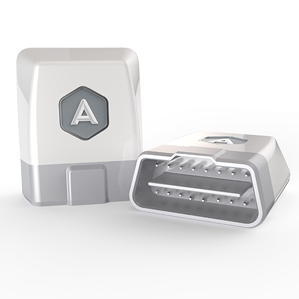Gadget Gets Under the Hood to Bring Analytics to Driving
You probably have a rough idea of how much you spend on gas each week, but chances are you don’t calculate the cost of each trip down to the penny. Unless you’re Ljuba Miljkovic, that is, who knows that in a recent week he spent $7.50 to drive over 47 miles.

Miljkovic is a cofounder of Automatic, an automotive tech startup that offers a small gadget that connects to your car’s onboard computer and wirelessly transmits the data it collects to your smartphone. This can reveal how efficiently you’re driving, how much individual trips are costing you, and tips for solving potential engine troubles. It can also determine where you parked your car and, if its built-in accelerometer senses you’ve been in an accident, call 911 for help.
The device combines two burgeoning trends—the “Internet of things,” where traditionally offline gadgets are connected to the Internet to amplify their usefulness (see “50 Disruptive Companies 2013: Nest’s Smarter Home”), and the mining of data that’s collected by our devices for meaning (see “Every Step You Take, Tracked Automatically”). By putting these two together, the company thinks it can get users to conserve gas and spend less—and make a profit itself while doing so.
“Your car is a black box today. You don’t know anything about it,” cofounder Thejo Kote says. “Using the information that is already there, and just presenting it in a useful way to people can have a really big impact on behavior and hopefully help people save money.”
Automatic grew out of research conducted by Kote and another of the company’s cofounders, Jerry Jariyasunant, while both were in graduate school in the systems engineering department of the University of California, Berkeley. Specifically, it blossomed from the realization that most people don’t really know anything about their cars, or about how much it really costs to drive, Kote says.

Automatic’s gadget plugs into the diagnostic port of your car—an outlet below the steering wheel of every car sold since 1997 that connects to the vehicle’s onboard computer and is used mainly by car mechanics for identifying and solving problems. The device will be available for people to preorder starting Tuesday, for $70, and will start shipping in May.
Phil Magney, who leads automotive electronics analysis at market researcher IHS, says the market for products that attach to your car’s diagnostic port and transmit data to your smartphone is growing. He adds that Automatic’s emergency-calling feature is a shrewd addition, giving it the ability to compete against telematics companies like OnStar.
The first step is to plug the device in and pair it with an Automatic app on your phone. When you start your car, the device will begin reading data—such as your speed—and send it to your smartphone via Bluetooth. That data is uploaded to Automatic’s servers for processing, and then sent back to the app in more user-friendly formats such as a driver score, on a scale of 1 to 100, that considers how often you brake hard, accelerate rapidly, and drive over 70 miles per hour (three factors that have a large impact on fuel efficiency).
A diagnostic feature can give you advice about what may be wrong if your “check engine” light comes on, and also enables you to turn the light off. A “beta” 911-calling feature uses the device’s built-in accelerometer to detect a car crash and notify Automatic to robocall your nearest 911 center with your name, car type, and approximate location.
Since the in-car device doesn’t have GPS—a decision Miljkovic says helps keep costs down—the app occasionally uses the phone’s GPS to reconstruct trips, determine where you parked, and estimate how much trips cost (the 1.4-mile trip to my office costs 33 cents, Miljkovic says). When you stop driving, the app automatically logs your location. And the device can tell when you add gas to the car, and which gas station you stopped at.
Initially, the company will offer only an iPhone app, since the two latest iPhones support low-power Bluetooth, but Kote says Automatic plans to release an Android version in the fall.
Sven Beiker, executive director of the Center for Automotive Research at Stanford University, says that while there are similar products on the market and in development aimed at “green” driving, Automatic’s solution is inexpensive and looks uncomplicated to use, which could help it catch on. “Very often if just the interface is appealing and easy to use, people will start changing their behavior,” he says.
Keep Reading
Most Popular
Large language models can do jaw-dropping things. But nobody knows exactly why.
And that's a problem. Figuring it out is one of the biggest scientific puzzles of our time and a crucial step towards controlling more powerful future models.
How scientists traced a mysterious covid case back to six toilets
When wastewater surveillance turns into a hunt for a single infected individual, the ethics get tricky.
The problem with plug-in hybrids? Their drivers.
Plug-in hybrids are often sold as a transition to EVs, but new data from Europe shows we’re still underestimating the emissions they produce.
Stay connected
Get the latest updates from
MIT Technology Review
Discover special offers, top stories, upcoming events, and more.